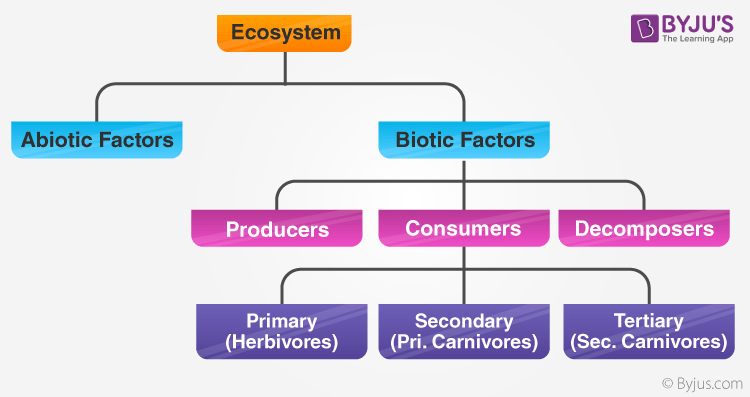Ecosystem Definition
“An ecosystem is defined as a community of lifeforms in concurrence with non-living components, interacting with each other.”
Table of Contents |

What is an Ecosystem?
The ecosystem is the structural and functional unit of ecology where the living organisms interact with each other and the surrounding environment. In other words, an ecosystem is a chain of interaction between organisms and their environment. The term “Ecosystem” was first coined by A.G.Tansley, an English botanist, in the year 1935.
Read on to explore the types, structure, components, types and functions of the ecosystem in the ecosystem notes provided below.
Types of Ecosystem
An ecosystem can be as small as an oasis in a desert, or as big as an ocean, spanning thousands of miles. There are two types of ecosystem:
- Terrestrial Ecosystem
- Aquatic Ecosystem
Terrestrial Ecosystems
Terrestrial ecosystems are exclusively land-based ecosystems. There are different types of terrestrial ecosystems distributed around various geological zones. They are as follows:
- Forest Ecosystems
- Grassland Ecosystems
- Tundra Ecosystems
- Desert Ecosystem
Forest Ecosystem
A forest ecosystem consists of several plants, animals and microorganisms that live in coordination with the abiotic factors of the environment. Forests help in maintaining the temperature of the earth and are the major carbon sink.
Grassland Ecosystem
In a grassland ecosystem, the vegetation is dominated by grasses and herbs. Temperate grasslands, savanna grasslands are some of the examples of grassland ecosystems.
Tundra Ecosystem
Tundra ecosystems are devoid of trees and are found in cold climates or where rainfall is scarce. These are covered with snow for most of the year. The ecosystem in the Arctic or mountain tops is tundra type.
Desert Ecosystem
Deserts are found throughout the world. These are regions with very little rainfall. The days are hot, and the nights are cold.
Aquatic Ecosystem
Aquatic ecosystems are ecosystems present in a body of water. These can be further divided into two types, namely:
- Freshwater Ecosystem
- Marine Ecosystem
Freshwater Ecosystem
The freshwater ecosystem is an aquatic ecosystem that includes lakes, ponds, rivers, streams, and wetlands. These have no salt content in contrast with the marine ecosystem.
Marine Ecosystem
The marine ecosystem includes seas and oceans. These have a more substantial salt content and greater biodiversity in comparison to the freshwater ecosystem.
Structure of the Ecosystem
The structure of an ecosystem is characterised by the organisation of both biotic and abiotic components. This includes the distribution of energy in our environment. It also includes the climatic conditions prevailing in that particular environment.
The structure of an ecosystem can be split into two main components, namely:
- Biotic Components
- Abiotic Components
The biotic and abiotic components are interrelated in an ecosystem. It is an open system where the energy and components can flow throughout the boundaries.

Structure of Ecosystem highlighting the biotic and abiotic factors
Biotic Components
Biotic components refer to all life in an ecosystem. Based on nutrition, biotic components can be categorised into autotrophs, heterotrophs and saprotrophs (or decomposers).
- Producers include all autotrophs such as plants. They are called autotrophs as they can produce food through the process of photosynthesis. Consequently, all other organisms higher up on the food chain rely on producers for food.
- Consumers or heterotrophs are organisms that depend on other organisms for food. Consumers are further classified into primary consumers, secondary consumers and tertiary consumers.
- Primary consumers are always herbivores that they rely on producers for food.
- Secondary consumers depend on primary consumers for energy. They can either be a carnivore or an omnivore.
- Tertiary consumers are organisms that depend on secondary consumers for food. Tertiary consumers can also be an omnivore.
- Quaternary consumers are present in some food chains. These organisms prey on tertiary consumers for energy. Furthermore, they are usually at the top of a food chain as they have no natural predators.
- Decomposers include saprophytes such as fungi and bacteria. They directly thrive on the dead and decaying organic matter. Decomposers are essential for the ecosystem as they help in recycling nutrients to be reused by plants.
Abiotic Components
Abiotic components are the non-living component of an ecosystem. It includes air, water, soil, minerals, sunlight, temperature, nutrients, wind, altitude, turbidity etc.
Functions of Ecosystem
The functions of the ecosystem are as follows:
It regulates the essential ecological processes, supports life systems and renders stability.
It is also responsible for the cycling of nutrients between biotic and abiotic components.
It maintains a balance among the various trophic levels in the ecosystem.
It cycles the minerals through the biosphere.
The abiotic components help in the synthesis of organic components that involves the exchange of energy.
Important Ecological Concepts
1. Food Chain
The sun is the ultimate source of energy on earth. It provides the energy required for all plant life. The plants utilise this energy for the process of photosynthesis, which is used to synthesise their food.
During this biological process, light energy is converted into chemical energy and is passed on through successive levels. The flow of energy from a producer, to a consumer and eventually, to an apex predator or a detritivore is called the food chain.
Dead and decaying matter, along with organic debris, is broken down into its constituents by scavengers. The reducers then absorb these constituents. After gaining the energy, the reducers liberate molecules to the environment, which can be utilised again by the producers.

A classic example of a food chain in an ecosystem
2. Ecological Pyramids
An ecological pyramid is the graphical representation of the number, energy, and biomass of the successive trophic levels of an ecosystem. Charles Elton was the first ecologist to describe the ecological pyramid and its principals in the year 1927.
The biomass, number, and energy of organisms ranging from the producer level to the consumer level are represented in the form of a pyramid; hence, it is known as the ecological pyramid.
The base of the ecological pyramid comprises the producers, followed by primary and secondary consumers. The tertiary consumers hold the apex. In some food chains, the quaternary consumers are at the very apex of the food chain.
The producers generally outnumber the primary consumers, and similarly, the primary consumers outnumber the secondary consumers. And lastly, apex predators also follow the same trend as the other consumers; wherein, their numbers are considerably lower than the secondary consumers.
For example, Grasshoppers feed on crops such as cotton and wheat, which are plentiful. These grasshoppers are then preyed upon by common mice, which are comparatively less in number. The mice are preyed upon by snakes such as cobras. Snakes are ultimately preyed on by apex predators such as the brown snake eagle.
In essence:
| Grasshopper →Mice→ Cobra → Brown Snake Eagle |
3. Food Web
Food web is a network of interconnected food chains. It comprises all the food chains within a single ecosystem. It helps in understanding that plants lay the foundation of all the food chains.
Main article: Food web
To learn more about what is an ecosystem, its structure, types, components, and functions, register at BYJU’S website or download BYJU’S app.
Frequently Asked Questions
1. What is the ecosystem?
The ecosystem is the community of living organisms in conjunction with non-living components of their environment, interacting as a system.
2. What are the different types of ecosystems?
The different types of the ecosystem include:
- Terrestrial ecosystem
- Forest ecosystem
- Grassland ecosystem
- Desert ecosystem
- Tundra ecosystem
- Freshwater ecosystem
- Marine ecosystem
3. Which ecosystem do we live in?
We live in a terrestrial ecosystem. This is the ecosystem where organisms live and develop in the soil and in the air that surrounds a specific terrestrial space.
4. What is the structure of the ecosystem?
The structure of the ecosystem includes the organisms and physical features of the environment, including the amount and distribution of nutrients in a particular habitat. It also provides information regarding the climatic conditions of that area.
5. Which is the largest ecosystem in the world?
The largest ecosystem in the world is the aquatic ecosystem. It comprises the freshwater and marine ecosystem. It constitutes 70% of the surface of the earth.
6. What is the major function of an ecosystem?
The ecosystem is the functional unit of the environment system. The abiotic components provide the matrix for the synthesis of organic components. This process involves the exchange of energy.
7. What makes a good ecosystem?
A good ecosystem consists of native plants and animal species interacting with each other and the environment. A healthy ecosystem has an energy source and the decomposers that break down dead plants and animal matter, returning essential nutrients to the soil.
8. What all include the non-living things in an ecosystem?
The non-living things in an ecosystem include air, wind, water, rocks, soil, temperature and sunlight. These are known as the abiotic factors of an ecosystem.
Register at BYJU’S for easy ecosystem notes. Refer to these notes for reference





0 Comments